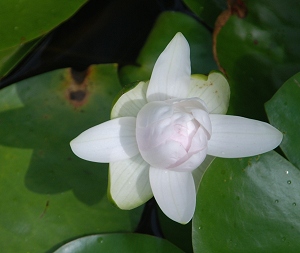When I went out yesterday about noon, I found four of these lovely pink waterlily flowers open:
 The year we built the lily pond, we put in three waterlilies: a pink, a white, and a yellow. Last year, when we cleaned out the overgrowth (of iris and lilies both) they weren’t in bloom, and I was afraid we might have discarded the pinks…but here they are. We also have some yellows, but the whites are gone. We still have too many lilies (too much mass of lilies, so they can’t spread their pads on the water) but no time this summer to get into the pond and separate and replant.
The year we built the lily pond, we put in three waterlilies: a pink, a white, and a yellow. Last year, when we cleaned out the overgrowth (of iris and lilies both) they weren’t in bloom, and I was afraid we might have discarded the pinks…but here they are. We also have some yellows, but the whites are gone. We still have too many lilies (too much mass of lilies, so they can’t spread their pads on the water) but no time this summer to get into the pond and separate and replant.
Yesterday’s finds included an ovipositing Widow Skimmer, Libellula luctuosa–the first time I’ve observed this species ovipositing. The female Widow Skimmers are handsome–black and gold–but I was unable to get a good picture. This dragonfly had a very different style than the Neon Skimmer. She hovered higher off the water, went in fast and dip-splashed only once before immediately rising to her hover/search altitude (about a foot). Then typically moved at least a foot away to drop for another dip-splash…and formed no pattern I could discern as she worked the west end of the lily pond and some overflow (from the recent rains) shallow puddles beyond it.
Two male Widow Skimmers were around the pond, though, and I did get pictures of them:
The dark and white wings are especially beautiful as they seem to “flicker” over the water. This one was patrolling the lily pond, and successfully defended the perching stick against a Neon Skimmer male–unusual, as I’ve seen in other years that the Neon Skimmer usually gets the high spot on the stick and the Widow Skimmer is lower. There was a tiny Blue Dasher perched below the Widow Skimmer.
The other male Widow Skimmer patrolled upstream of the lily pond and had a favorite perch much lower than this, near Round Pool: 
Perching right on Round Pool, on emergent vegetation, was a male Blue Dasher:
Round Pool itself had become totally choked with irises, so last year we cleaned it out completely, replanting only a few clumps around the edges, a few other plants as well, and leaving most of the surface open. It wasn’t open for long, as water striders are all over it:
Upstream of Round Pool, the stream section is at least partly shady. Neon Skimmers and Blue Dashers are the dominant dragonflies here, but we also see damselflies perching on the ground or on rocks, like this Kiowa Dancer, Argia immunda:
Odonates are predators in both their immature and mature forms, but they’re also prey for other predators. Besides the fishing spiders, other spiders may attack them, including the big orbweaver Argiope aurantia.
This spider spins large, beautifully constructed webs in the water iris when it’s tall enough (it also spans openings between bushes out on the land, where I’ve witnessed it capturing and killing a Common Green Darner, quite a large dragonfly.) With so many insects–not just odonates–in and around water, this is a good spot for a spider to try for dinner.
Both these spiders had spun webs in the water irises of Round Pool; I’m sure there are more in the larger iris bed in the lily pond.
As the day wanes, waterlily flowers begin to close up for the night:







Comment by Steve Willson — July 1, 2010 @ 12:17 pm
I started with the same three waterlily colors and lost the yellow right away. Pink and white are thriving. Your water garden supports an amazing diversity of animals. Mine is much smaller and can’t accomodate much of a crowd.
Comment by elizabeth — July 1, 2010 @ 1:50 pm
The yellow was recommended to us (the specific yellow we got) as foolproof in our climate, and for ten years it spread more than the other two. Not the most intense yellow–in fact, it fades to near-white in midsummer with our fierce sun and heat–but reliable and tough. The pink seemed the least robust in the beginning but is now doing extremely well.
Your pond is 12×25; ours is 10×20, but does have the “upper reach” of the artificial creek. Our one-foot-deep “shallows” are wider than yours, but I think we made it down to 36 inches in the middle. One time I estimated the capacity of our whole system and got about 2000 gallons. We may have a climate advantage–freezing temperatures last only a few days, usually. How old is your pond? Ours definitely got more critters as it’s aged (we added the lily pond to the upper pool in 2000.)
Comment by Adrianne — July 1, 2010 @ 1:53 pm
It’s amazing how often you inadvertently answer my questions. I was wondering what those dashing black and white dragonflies were. I will remember “Widow Skimmers.” They’re very handsome, though my lens wasn’t long enough to get a decent photo.
I love the water lily.
Comment by elizabeth — July 1, 2010 @ 4:36 pm
Be sure it’s exactly this pattern…there are other dragonflies with dark and white on the wings in other patterns (just as the males, females, and just-emerged adults all look different, and some species of damselflies have females that can come in either of several colors. EEEEP!) I love the twinkling effect of the spotted-winged dragonflies–have you seen a Halloween or Calico Pennant yet?
There’s a not-great picture of a female Widow Skimmer here: http://www.elizabethmoon.com/archive/land-2003june.htm
Comment by green_knight — July 2, 2010 @ 9:27 am
I’m in awe of your dragonfly pictures, as I do not find them easy to capture at all. Thank you for sharing!
Comment by elizabeth — July 2, 2010 @ 10:36 am
You should see all my BAD dragonfly pictures. HUNDREDS of bad dragonfly pictures. Remember, I’ve been trying to get good ones for years–first achieved in maybe 2003 or 2004, and even then with less than 1/10 of them worth saving. Now it’s up to one good shot out of 3-5. You do need a camera that has no delay between pushing the button and capturing the image–so in digital, you need a camera w/o delay, which means more expensive, alas.
Then you learn where they tend to perch (not same for all species) and how you can sneak up on them. They’re MUCH easier to photograph when they’re holding still or almost still.
Males often perch on bare sticks or twigs that are near, or extending over, water: they’re hoping to catch a female that’s come to oviposit and chase away competitors. If you have a pond, get some thin sticks and put them in the ground angling over or toward the water. Some species perch more than others (Blue Dashers perch a lot; Widow Skimmers perch some; Neon Skimmers perch much less often than either.)
Females, immature males and some species perch away from water (if you walk along a hedgerow you may startle some who are perched there, sallying out to catch their prey. Some woodland species will be found away from water as well.) After awhile, you learn to recognize the glitter of wings from a distance, and track down where that one has landed. (Though some species, like Wandering Glider, perch over head height in trees and are really hard to find–the only ones I’ve photographed I spotted only by wing glitter.)
Most will return to a favorite perch after being disturbed if you’re not too close…so if one flies away, hold still. Focus on the perch so you’re pre-focused. Then when they return–SNAP. They have excellent vision and react to movement. A zoom lens really helps…from eight feet away, most won’t be disturbed if you’re moving very slowly. That’s not close enough for damsels, but you can get good damsel shots with an ordinary zoom because they’re not as reactive to your being close. More pixels help, because for damsels in particular you’re going to be working with small fractions of the total image unless you have serious pro equipment (like I don’t have–huge long lenses, for instance.) For damsels, because they’re so tiny, really good quality glass helps.
Comment by Steve Willson — July 2, 2010 @ 9:36 pm
Elizabeth – My water garden was put in 10 years ago. There were radical changes in the fauna the first 5 or 6 years, but things are beginning to settle down a bit now.
My biggest problem was when bullfrogs moved in and ate everything they could get their mouths around. After they were evicted things began to achieve a better balance.
The pond is usually completely iced over for 2 or 3 months each year. I measured the ice to be 9 inches thick a few years ago.
Having a water garden is certainly fun and I really enjoy reading about yours.
Comment by elizabeth — July 3, 2010 @ 9:59 pm
So our water gardens are about the same age. Yeah, we had radical shifts the first few years but then things settled down.
R- saw a snapping turtle in the creekbed today–in broad (cloudy) daylight, dragging itself upstream because despite the 4 inches of rain this week (first in months) the creek is not flowing. We’d need another four to re-establish flow from upstream. He did not, alas, have a camera with him. I think this is only the second time we’ve IDed a snapping turtle on the place–there was one a few years back in a very wet period that hung around for a few weeks.
Comment by Martin LaBar — July 7, 2010 @ 9:50 am
More beauty! Thanks!
Comment by Marian — July 10, 2010 @ 5:35 am
Your dragonflies are so pretty. So much better than our boring brown ones – although we dont seem to need standing water to get them, they show up in my (essentially waterless) garden all the time in summer.
Comment by elizabeth — July 10, 2010 @ 9:27 am
I remember seeing a big dragonfly with some color at the zoo in Perth a few years ago–I had no camera with me. It was near a large pond complex. If it’s possible to put in a water garden, even a fairly small one, with some emergent vegetation (and I know it’s not always possible) you might attract males, which are more brightly colored in general. A lot of female dragonflies aren’t nearly as bright.